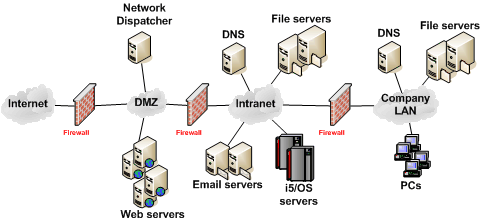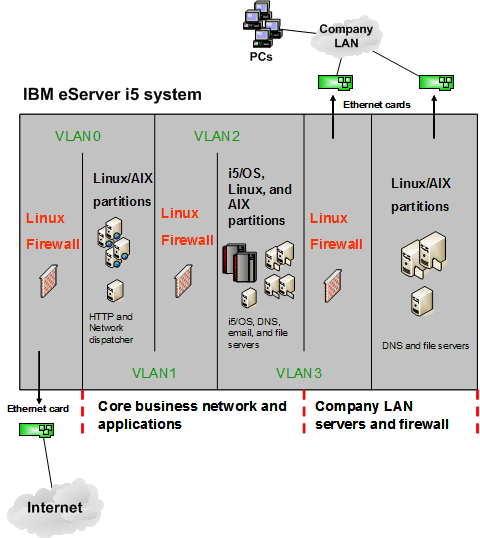The advent of the Internet has had a tremendous impact on businesses. Virtually every business, no matter its size, has a presence on the Internet. But this presence comes at a cost. Typically, a business has several firewalls, routers, switches, Web servers, email servers, DNS servers, file servers, and DB application servers as a part of its Internet presence. More often than not, those servers are running heterogeneous operating systems that include expenses such as hardware maintenance contracts, software support contracts, software licenses, software upgrades, and separate administrative staff for the different operating environments. A great way to reduce these excessive costs is to consolidate the many servers onto your eServer i5 system. The i5's advanced partitioning capabilities allow a business to consolidate i5/OS, AIX, Linux, and Windows servers (Windows requires optional integrated xSeries adapters) onto one system to reduce, if not eliminate, these excessive costs.
Consolidating these various servers onto your i5 allows you to maximize the use of your resources. With the i5, you can dynamically allocate processors, memory, and storage to i5/OS, AIX, and Linux. Windows servers on an i5 system support dynamic allocation of storage only.
In an environment with many different physical servers, there will always be systems that are underutilized and systems that are overutilized. For example, your email server may be using only 50% of its processing capacity while your Web servers are struggling to keep up with all your Web transactions during peak business times. By consolidating your servers, you can dynamically move processing power between partitions without bringing them down or interrupting their workloads. You can decide where the processing power is needed most and then change it dynamically anytime it's needed elsewhere.
In addition, i5/OS, Linux, and AIX servers support dynamic allocation of memory. AIX and i5/OS allow you to allocate additional memory and remove excess memory on the fly. Linux has the same capability to add and remove memory, but the Linux partition must be powered down and restarted for the memory change to take effect. This flexibility for moving memory resources ensures all the servers have the right amount of memory when they need it.
Storage is assigned to each i5/OS, Linux, AIX, and Windows server when it's created on the i5 system. Linux and AIX support either physical disk units or virtual disks units. The virtual disk units are carved out from an i5/OS partition's storage. Windows servers support only virtual disk units that are carved out from an i5/OS partition's storage. Virtual disk units that are created from an i5/OS partition have several advantages over physical disk units:
- Single backup and recovery solution--Virtual disk units that are created for AIX/Linux/Windows servers are simply network server storage objects (NWSSTG objects) that reside on the hosting i5/OS partition. This allows a single backup solution for the hosting i5/OS partition and all the hosted servers. When you back up the i5/OS hosting partition, the virtual disk units will also get backed up. The NWSSTG objects can be restored individually at any time or restored with the hosting i5/OS partition in case of a disaster recovery situation. However, it is important to realize that if any physical disk units are assigned in addition to the virtual disk units, only the virtual disk units are backed up when the hosting i5/OS system is saved. For this reason, partitions that have physical disk units require a separate backup solution for data residing on the physical disk units.
- Automatic disk protection--Since the NWSSTG objects reside on the i5/OS partition, they automatically take advantage of the eServer i5 system's disk mirroring and RAID-5 capabilities without having to configure any disk protection on the AIX/Linux/Windows servers themselves.
- Dynamic creation and allocation of virtual disks--Additional virtual disk units can be created and dynamically added to AIX, Linux, and Windows servers while they are up and running. The only consideration is that the hosting i5/OS must have enough free storage available to create the additional virtual disk units. Physical disk units can also be dynamically added to AIX and Linux servers while they are up and running. However, this requires that the i5 system have physical disk units that are not assigned to any other partition. Also, AIX and Linux cannot utilize any storage adapter that is on the same bus as a Combined Function IOP. The one exception to this restriction is if the storage adapter comes before the IOP on that bus.
- Increased availability for AIX/Linux servers--Using virtual disks in a specific configuration allows for AIX and Linux servers to be backed up without having to take them down. This is accomplished by using software RAID 1 (disk mirroring) across virtual disks hosted by separate i5/OS partitions.
There are other benefits beyond maximum resource utilization. Consolidating servers onto your i5 also allows you to use the virtual Ethernet for high-speed communication between partitions. The i5 allows you to create up to 4,094 virtual Ethernet LANs that run at bus speeds. Partitions on the i5 can use any of these virtual Ethernet LANs to communicate with other partitions. Not only is the virtual Ethernet fast, it is also secure as it is a virtual entity contained entirely within the i5 system. There is no external switch or hub that could be compromised to monitor traffic. In fact, by consolidating all AIX/Linux servers onto the i5, it is possible to replace some existing switches or hubs. This would allow you to eliminate any support/maintenance contracts associated with that network hardware. Alternatively, that hardware could be used elsewhere in the network infrastructure. Consolidation also helps to simplify any existing physical network by removing Ethernet cables and reducing congestion.
An Example Server Consolidation
For this example, we will consider a fictitious business that has an existing Web presence and a network configuration as shown in Figure 1.
Figure 1: Many companies' network configurations look something like this. (Click images to enlarge.)
This particular business uses three hardware firewalls to secure its three networks: the demilitarized zone (DMZ), the intranet, and the company LAN. The DMZ consists of one or more network dispatchers (load balancers) and several Web servers. The intranet consists of one or more DNS servers, several file servers, several email servers, and one or more i5/OS servers. The company LAN consists of one or more DNS servers, several file servers, and employee PCs. The various servers are running on a mix of AIX, Linux, and Windows operating systems. As the number of servers grows, this business realizes its environment is getting harder to manage and more costly to operate.
After considering the many benefits of server consolidation, this business decides to consolidate its many servers onto a single i5 system. The consolidation will bring all the existing i5/OS, AIX, Linux, and Windows servers onto one i5 system running several partitions. The business will migrate its Windows servers onto Linux servers to help save on licensing costs and take advantage of the greater resource utilization on the i5. In addition, the business will use Linux firewalls to replace its hardware firewalls for the same reasons. The configuration after the server consolidation is logically the same as the configuration before it. However, now the configuration has greater resource utilization, faster network speeds over virtual Ethernet, easier management, and less complexity. The new configuration after the server consolidation is shown in Figure 2.
Figure 2: Here's the same network after consolidation.
As you can see, the first Linux firewall separates the Internet from the HTTP servers on virtual Ethernet LAN zero (VLAN0). A second Linux firewall is connected to virtual Ethernet LANs one (VLAN1) and two (VLAN2) and separates the HTTP servers from the application servers, email servers, and file servers. The third Linux firewall uses virtual Ethernet LAN three (VLAN3) to separate the application servers, email servers, and file servers from the company's own LAN.
This single example illustrates the powerful partitioning capabilities of the eServer i5 system and shows what server consolidation can do for a business. With the release of i5/OS V5R3 and the i5, server consolidation has never been easier. Never before could you run i5/OS, AIX, Linux, and Windows on the same server. In addition, you can dynamically manage processor, memory, and disk resources for all your i5/OS, AIX, and Linux partitions. The advanced logical partitioning capabilities of the i5 provide virtually unlimited flexibility for consolidating servers.
This article is an excerpt from a more-extensive article. For more information about server consolidation using your eServer i5, see the full article in the IBM eServer iSeries Information Center V5R3. You can also check out the IBM eServer Hardware Information Center and the IBM Servers – Server Consolidation Web sites.
Brett Leeser is a Staff Software Engineer on the IBM Customer Test team located at the Rochester, Minnesota, laboratory. He has over five years of experience in the software testing field. His areas of expertise include i5/OS, networking, and Linux. Brett can be reached at
Steven Janssen is a Staff Software Engineer on the IBM Customer Test team located at the Rochester, Minnesota, laboratory. He has over five years of experience in the software testing field. His areas of expertise include i5/OS hardware and software, IBM eServer logical partitioning, high availability configurations, and Linux. Steven can be reached at













 Business users want new applications now. Market and regulatory pressures require faster application updates and delivery into production. Your IBM i developers may be approaching retirement, and you see no sure way to fill their positions with experienced developers. In addition, you may be caught between maintaining your existing applications and the uncertainty of moving to something new.
Business users want new applications now. Market and regulatory pressures require faster application updates and delivery into production. Your IBM i developers may be approaching retirement, and you see no sure way to fill their positions with experienced developers. In addition, you may be caught between maintaining your existing applications and the uncertainty of moving to something new. IT managers hoping to find new IBM i talent are discovering that the pool of experienced RPG programmers and operators or administrators with intimate knowledge of the operating system and the applications that run on it is small. This begs the question: How will you manage the platform that supports such a big part of your business? This guide offers strategies and software suggestions to help you plan IT staffing and resources and smooth the transition after your AS/400 talent retires. Read on to learn:
IT managers hoping to find new IBM i talent are discovering that the pool of experienced RPG programmers and operators or administrators with intimate knowledge of the operating system and the applications that run on it is small. This begs the question: How will you manage the platform that supports such a big part of your business? This guide offers strategies and software suggestions to help you plan IT staffing and resources and smooth the transition after your AS/400 talent retires. Read on to learn:
LATEST COMMENTS
MC Press Online